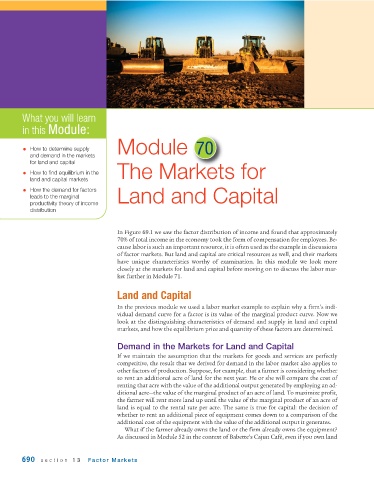Page 732 - Krugmans Economics for AP Text Book_Neat
P. 732
What you will learn
in this Module:
• How to determine supply Module 70
and demand in the markets
for land and capital
• How to find equilibrium in the The Markets for
land and capital markets
• How the demand for factors
leads to the marginal Land and Capital
productivity theory of income
distribution
In Figure 69.1 we saw the factor distribution of income and found that approximately
70% of total income in the economy took the form of compensation for employees. Be-
cause labor is such an important resource, it is often used as the example in discussions
of factor markets. But land and capital are critical resources as well, and their markets
have unique characteristics worthy of examination. In this module we look more
closely at the markets for land and capital before moving on to discuss the labor mar-
ket further in Module 71.
Land and Capital
In the previous module we used a labor market example to explain why a firm’s indi-
vidual demand curve for a factor is its value of the marginal product curve. Now we
look at the distinguishing characteristics of demand and supply in land and capital
markets, and how the equilibrium price and quantity of these factors are determined.
Demand in the Markets for Land and Capital
If we maintain the assumption that the markets for goods and services are perfectly
competitive, the result that we derived for demand in the labor market also applies to
other factors of production. Suppose, for example, that a farmer is considering whether
to rent an additional acre of land for the next year. He or she will compare the cost of
renting that acre with the value of the additional output generated by employing an ad-
ditional acre—the value of the marginal product of an acre of land. To maximize profit,
the farmer will rent more land up until the value of the marginal product of an acre of
land is equal to the rental rate per acre. The same is true for capital: the decision of
whether to rent an additional piece of equipment comes down to a comparison of the
additional cost of the equipment with the value of the additional output it generates.
What if the farmer already owns the land or the firm already owns the equipment?
As discussed in Module 52 in the context of Babette’s Cajun Café, even if you own land
690 section 13 Factor Markets

